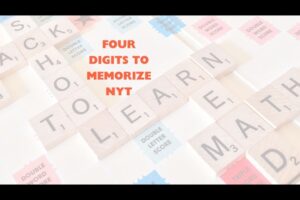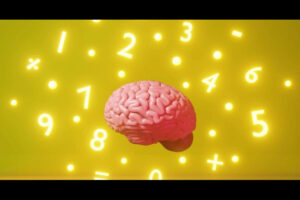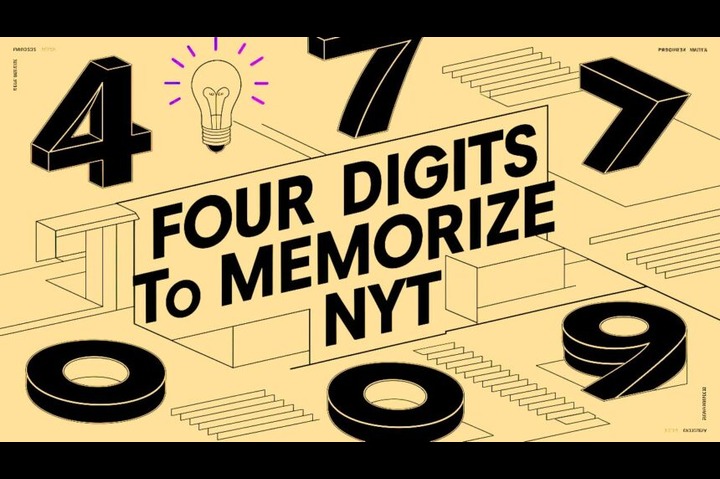Four Digits To Memorize NYT: Full Details (2024)
Introduction to Four Digits To Memorize NYT
Memorizing numerical sequences can be a daunting task for many, but employing creative techniques can turn this challenge into an engaging and memorable experience. One such approach revolves around the concept of associating numbers with familiar patterns or stories, a method particularly effective when applied to the task of remembering four-digit numbers. The New York Times, a venerable institution in the world of journalism, often becomes a fixture in our daily routines, representing a wealth of information, narratives, and data. Leveraging the rich tapestry of associations that the New York Times evokes, from its historic headlines to its diverse sections, can provide a unique mnemonic framework.
This method transforms the act of memorization from a mere cognitive exercise into a vivid mental journey, wherein each digit can be linked to a specific element or article, making the four-digit sequence not only easier to recall but also imbued with a personal significance. By intertwining numerical memory techniques with the familiar and multifaceted world of the New York Times, we can create a powerful tool that is both effective and deeply engaging, enhancing our ability to retain and recall numbers with ease and confidence.

How Does the NYT Memory Challenge Work?
The New York Times (NYT) Memory Challenge leverages the power of association and storytelling to make memorizing four-digit numbers easier and more engaging. The challenge works by connecting each digit of the number to a specific element from the New York Times, such as an article, headline, image, or section. Here’s how it functions in a step-by-step manner:
Digit Association:
Each digit from 0 to 9 is assigned a specific element related to the New York Times. For example, the digit 1 might be linked to a famous headline, 2 to a particular columnist, 3 to a notable image, and so on. These associations are designed to be intuitive and memorable, utilizing familiar NYT content.
Creating a Narrative:
Once the digits are associated with specific NYT elements, the next step is to create a narrative or story that links these elements together. For instance, if the number to be memorized is 1234, you might craft a story where a famous headline (1) leads you to read an article by a specific columnist (2), which features a notable image (3), and concludes in a particular section of the newspaper (4).
Visualization:
Visualization is key to the NYT Memory Challenge. By mentally picturing the story you’ve created, you reinforce the associations between the digits and the NYT elements. This vivid mental imagery helps embed the number in your memory.
Repetition and Practice:
Like any memory technique, repetition is crucial. Regularly practicing with different four digits to memorize number and crafting new narratives each time helps solidify the process, making it second nature over time.
Recalling the Number:
When it’s time to recall the number, you simply walk through the story you’ve created in your mind. Each element of the story cues the corresponding digit, allowing you to retrieve the entire sequence effortlessly.
The NYT Memory Challenge transforms a potentially mundane task into an engaging mental exercise, utilizing the familiar and rich content of the New York Times to create strong, memorable associations. This method not only improves your ability to remember numbers but also enhances cognitive abilities by encouraging creativity and detailed visualization.

Understanding the Benefits of Memorization Methods
Memorization methods offer a wide array of benefits that extend far beyond the simple retention of information. These techniques enhance cognitive functions, improve learning efficiency, and foster creativity, providing a robust toolkit for both academic and everyday applications. Understanding these benefits can highlight why investing time in mastering memorization methods is so valuable.
First and foremost, effective memorization methods significantly boost cognitive abilities. By engaging in activities that require memory, such as creating associations and stories, you stimulate various parts of the brain. This mental exercise enhances neural connections, leading to improved overall brain function. As a result, individuals often experience better problem-solving skills, sharper focus, and enhanced mental agility. This cognitive boost is not just beneficial for academic pursuits but also for everyday decision-making and critical thinking.
Another key benefit is the increase in learning efficiency. Traditional rote memorization can be tedious and time-consuming, often leading to quick forgetting. In contrast, structured memorization methods, such as mnemonic devices or visualization techniques, make the learning process more engaging and less monotonous. These methods help encode information more deeply into long-term memory, reducing the need for repetitive review and making recall faster and more reliable. This efficiency can be especially beneficial for students, professionals, and anyone needing to absorb large amounts of information quickly.
Memorization methods also enhance creativity. Techniques such as the method of loci, where you visualize placing information in specific locations, or storytelling, where you create narratives around the information, encourage imaginative thinking. By regularly practicing these methods, you train your brain to think more creatively and flexibly. This creative thinking is not only useful for memorization but can also be applied to other areas of life, such as problem-solving, brainstorming, and artistic endeavors.

Importance of Four Digits To Memorize NYT
Memorizing a sequence of four digits to memorize NYT might seem like a trivial task, but when framed within the context of the New York Times (NYT), it takes on a unique significance. The importance of mastering this memorization technique extends into various realms, from enhancing cognitive skills to fostering a deeper engagement with content.
Firstly, the process of memorizing four-digit numbers associated with the NYT strengthens cognitive abilities. It requires active engagement of memory, attention, and associative thinking. By linking each digit to a specific NYT element, such as a headline, article, or section, you create a mental map that enhances neural connections. This mental exercise is akin to a workout for the brain, promoting better retention and recall abilities, which are essential for both academic and professional success.
Additionally, using the four digits to memorize NYT as a mnemonic framework taps into the power of context and familiarity. The NYT is a treasure trove of diverse and rich content, from breaking news to in-depth analyses and human-interest stories. Associating digits with elements of the NYT leverages this familiarity, making the memorization process more intuitive and engaging. This method turns an abstract sequence of numbers into a series of meaningful associations, which are easier to remember and recall.
Moreover, this technique fosters a deeper connection with the content of the NYT. As you create associations between digits and specific articles or headlines, you are not only memorizing numbers but also engaging with the content on a deeper level. This can lead to a more thorough understanding and retention of the material you are reading. For instance, linking the digit 1 to a major headline about climate change encourages you to think more deeply about that issue each time you recall the number.
Additionally importance of memorizing four digits using the NYT
Practically speaking, the ability to quickly and accurately recall four-digit sequences has numerous applications. Whether it’s remembering PIN codes, dates, or key statistics, this skill can streamline many aspects of daily life. In the context of the NYT, it could help in recalling publication dates of significant articles or remembering subscription numbers and access codes, enhancing your overall interaction with the newspaper.
Furthermore, the memorization of four-digit sequences using the NYT method enhances learning efficiency. Traditional rote memorization can be time-consuming and prone to quick forgetting. In contrast, mnemonic techniques grounded in familiar and meaningful contexts, like the NYT, promote deeper encoding of information into long-term memory. This means less time spent on repetitive review and more reliable recall when needed.
This method can build confidence and reduce anxiety, particularly in high-stakes situations such as exams or professional presentations. Knowing you have a reliable strategy for memorizing and recalling important numbers can alleviate stress and improve performance.
The importance of memorizing four digits using the NYT lies in its cognitive benefits, enhanced engagement with content, practical applications, improved learning efficiency, and increased confidence. This technique transforms a simple memorization task into a powerful tool for intellectual growth and practical utility, demonstrating that even seemingly small skills can have a significant impact when approached creatively and thoughtfully.

The Advantages of Four Digits to Memorize NYT
The practice of memorizing four-digit numbers using the framework of the New York Times (NYT) offers a range of advantages that enhance cognitive abilities, improve memory retention, and deepen engagement with content. This method transforms a simple mnemonic exercise into a multifaceted tool with broad applications.
One of the primary advantages is the enhancement of cognitive function. Memorizing numbers through association with NYT elements requires active mental engagement, stimulating brain regions involved in memory, attention, and visualization. This mental workout strengthens neural connections, improving overall cognitive agility and the ability to retain and recall information. This cognitive boost is not only beneficial for academic and professional endeavors but also enhances everyday mental tasks.
Additionally, utilizing the NYT for memorization leverages familiarity and context, making the process more intuitive and effective. The NYT’s rich and diverse content—from headlines and articles to images and sections—provides a wealth of material to create meaningful associations. These associations transform abstract numbers into memorable and concrete mental images, facilitating easier recall. For example, linking the digit 2 to a memorable NYT headline about space exploration creates a vivid mental picture that is easier to remember than the number alone.
Another significant advantage is the deeper engagement with the NYT content. By associating digits with specific articles or headlines, you naturally spend more time thinking about and understanding the material. This deeper interaction enhances comprehension and retention of the content, making the information more memorable and meaningful.
Improves learning efficiency
Practically, the ability to memorize and recall four-digit sequences has numerous real-world applications. This skill is useful for remembering PIN codes, dates, important statistics, and other key numbers encountered in daily life. In the context of the NYT, it can help with recalling publication dates of significant articles, remembering subscription details, or even tracking recurring themes and topics in the newspaper.
Furthermore, this method improves learning efficiency. Traditional rote memorization techniques often require extensive repetition and can be prone to quick forgetting. In contrast, mnemonic techniques based on familiar and meaningful contexts, such as those provided by the NYT, promote deeper encoding of information into long-term memory. This means less time spent on repetitive review and more reliable recall when needed.
The advantages of memorizing four digits using the NYT framework are multifaceted. This method enhances cognitive function, leverages familiarity and context for easier recall, deepens engagement with content, has practical real-world applications, improves learning efficiency, and builds confidence. By transforming a simple mnemonic exercise into a powerful cognitive tool, this technique demonstrates the profound impact that creative and thoughtful approaches to memorization can have on both intellectual growth and practical utility.

What Role Does Visualization Play in Four Digits To Memorize NYT?
Visualization plays a crucial role in the process of memorizing four-digit numbers using the New York Times (NYT) as a framework. This technique transforms abstract numerical data into vivid mental images, making it easier to encode, store, and retrieve information. Here’s how visualization enhances this memorization method:
Visualization acts as a bridge between numbers and meaningful content. By associating each digit with a specific element from the NYT, such as a headline, image, or article, you create a visual story that is more memorable than the numbers alone. For instance, if the digit 4 is linked to a famous NYT photograph, visualizing that image each time you encounter the number makes it more distinctive and easier to recall.
This method leverages the brain’s natural preference for visual information. Humans are inherently good at remembering images and spatial relationships. By converting numerical data into visual representations, you align the memorization process with the brain’s strengths, enhancing retention and recall. Visual images are typically more complex and engaging than abstract numbers, which helps create stronger and more durable memories.
Visualization also helps in creating a cohesive and structured mental narrative. When you link each digit to a different NYT element and then visualize these elements in a specific sequence, you form a mental story or journey.
Things to memorize
Additionally, visualization enhances engagement and interest. Creating vivid mental images and stories around NYT content transforms memorization from a rote task into an engaging activity. This increased engagement not only makes the process more enjoyable but also leads to better focus and deeper processing of the information, which are critical for effective memorization.
Moreover, visualization can aid in overcoming memory blocks. If you forget part of a numerical sequence, visualizing the associated NYT content can trigger the recall of the missing digit. For instance, if you remember the NYT article but not the specific digit, revisiting the mental image of the article can help retrieve the associated number.
This technique also supports long-term retention. Visual stories and images are stored more effectively in long-term memory than abstract information. By repeatedly visualizing and mentally reviewing these NYT-based images and stories, you reinforce the memory traces, making the four-digit sequences easier to remember over longer periods.
Visualization plays a pivotal role in the NYT memorization method by transforming abstract numbers into memorable images and stories, leveraging the brain’s strengths, creating structured narratives, enhancing engagement, aiding in overcoming memory blocks, and supporting long-term retention. This powerful cognitive tool not only makes the memorization of four-digit numbers more effective but also enriches the overall learning experience.
How to Use the Four-Digit Memorization Technique?
Using the four-digit memorization technique involves a structured approach that combines association, visualization, and storytelling to effectively encode and recall numbers. Here’s a step-by-step guide on how to use this method, specifically leveraging elements from the New York Times (NYT):
Assign Digits to NYT Elements:
These elements could be a memorable headline, a notable journalist, a distinctive section (like Sports or Arts), or an iconic image. For instance:
- 0: Front page headline
- 1: Editorial section
- 2: Popular columnist
- 3: Investigative article
- 4: Historical photograph
- 5: Political cartoon
- 6: Feature story
- 7: International news section
- 8: Science and technology article
- 9: Book review
Engage Your Imagination:
Make the visualizations as detailed and vivid as possible. Include colors, actions, and emotions to make the images more memorable. For example, see the columnist passionately typing away, the historical photograph in sharp detail, the bustling activity in the international news section, and the futuristic feel of the science article.
Practice the sequence:
Mentally rehearse the story several times. Walk through the visual narrative in your mind, ensuring you clearly see and feel each part of the sequence. The more vividly you can picture the story, the stronger your memory of the four-digit number will be.
Use repetition and review.
Periodically review your visual stories to reinforce the associations. Repetition helps solidify the connections in your long-term memory, making it easier to recall the sequence whenever needed.
Apply the technique to real-life situations:
Start using this technique in real-life situations. Whether it’s remembering a PIN code, a date, or key statistics, create NYT-based visual stories for each four-digit sequence. The more you practice, the more efficient and effective you’ll become at using this method.
- Adapt and personalize:
Feel free to adapt the associations to better suit your preferences and experiences. The more personal and relevant the associations, the more effective the memorization. If a particular columnist or section of the NYT resonates more with you, use those elements to make your visual stories stronger. By following these steps, you can harness the power of the four-digit memorization technique using the rich and varied content of the New York Times. This method transforms a mundane task into an engaging mental exercise, leveraging visualization and storytelling to enhance memory retention and recall.
Conclusion About things to memorize
The four-digit memorization technique using the New York Times (NYT) framework is a powerful and effective method for enhancing memory retention and recall. By associating each digit with specific NYT elements, such as headlines, articles, or sections, and creating vivid visual stories, this technique leverages the brain’s natural preference for visual information and narrative structure. This method not only boosts cognitive function and learning efficiency but also deepens engagement with the content, making the process more intuitive and enjoyable.
The structured approach of assigning digits to familiar NYT elements, visualizing detailed mental stories, and practicing these narratives transforms abstract numbers into memorable images. This technique aids in overcoming memory blocks, supports long-term retention, and can be adapted to various real-world applications, from remembering PIN codes to recalling key statistics. Moreover, the personalization aspect allows for a tailored experience that aligns with individual strengths and preferences, further enhancing the effectiveness of the method.
Overall, the four-digit memorization technique using the NYT framework is a versatile and valuable tool, demonstrating that creative and thoughtful approaches to memorization can significantly impact intellectual growth and practical utility. By incorporating visualization and storytelling into the memorization process, individuals can achieve greater confidence, reduce anxiety, and improve their ability to recall important information efficiently. Lastly, these methods can be highly personalized, allowing you to tailor techniques to your unique strengths and preferences. Whether you prefer visual aids, auditory cues, or kinesthetic activities, there’s a memorization strategy that can be adapted to suit your style. This personalization makes the process more enjoyable and effective, fostering a deeper connection with the material.
FAQs:
What is the four-digit memorization technique using the NYT framework?
The four-digit memorization technique using the NYT framework is a method where each digit from 0 to 9 is associated with a specific element from the New York Times, such as headlines, articles, or sections. By creating vivid mental images and stories around these elements, individuals can more easily encode, store, and recall four-digit numbers.
How do I create associations for each digit with NYT elements?
To create associations, start by assigning each digit a specific NYT element that is memorable and distinct. For example, the digit 1 could be linked to the editorial section, 2 to a popular columnist, 3 to a notable image, and so on. The goal is to choose elements that are meaningful to you and can be easily visualized.
Why is visualization important in this memorization technique?
Visualization is crucial because the brain naturally remembers images and stories better than abstract numbers. By transforming digits into detailed mental images related to NYT content, you create strong, memorable associations that enhance recall. Visualization also makes the process more engaging and less monotonous.
How can this technique be applied in real-life situations?
This technique can be applied in various real-life situations, such as remembering PIN codes, dates, important statistics, and other four-digit sequences. By creating and practicing visual stories for each sequence, you can quickly and reliably recall the information whenever needed.
Can the associations and visualizations be personalized?
Yes, personalization is encouraged to make the technique more effective. You can adapt the associations to fit your preferences and experiences. The more relevant and personal the associations, the stronger the memory connections will be. Feel free to use NYT elements that resonate most with you to create vivid and meaningful visual stories.






